Sound of Spaces (28. Oktober 2021 - 13. March 2022)
The Museum VILLA STUCK presents the most comprehensive solo exhibition to date of Nevin Aladağ featuring a selection of installations, sculptures, textiles, video works and performances. Since the 1990s, the internationally renowned artist has been exploring music and sound as media of art. Playfully and with a keen sense of irony, she combines images and sounds to reveal surprising elective affinities that evoke a wide array of associations. In Aladağ’s world the everyday is set in motion, objects start making music, are transformed and let the imagination run free. In the process Aladağ tests the limits of cacophony, examining when a harmonious overall image is formed without giving up the individuality of the various sound traces. To this end, she experiments with the sound properties of different objects and their simultaneous effect in a variety of media. The resulting diverse, multidisciplinary work can be viewed for the first time in such a broad selection.
The exhibition presents recent works, some created especially for this project, in a dialogue with older work. This juxtaposition highlights recurring motifs and strategies that – very much in line with the principle informing individual works – comment on one another to produce something new. The result is a subtle and humorous “score” that runs through the entire museum, from the historical rooms to the private living quarters and the new studio.
Curator and author: Dr. Helena Pereña
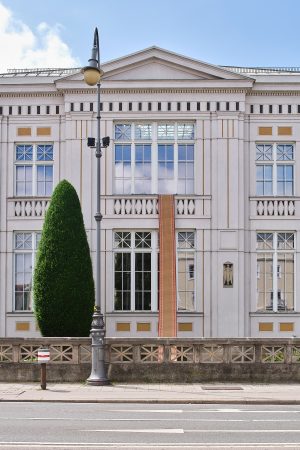
Läufer [Rug], 2021
(photo credit: Jann Averwerser)
Garden and Facade
Displayed on the museum’s façade are two works in which Nevin Aladağ plays with the permeability of public and private space, a particularly evocative theme in the former residence of Franz von Stuck. “Voyeur” (1996), a video projection that only becomes visible after dark, shows the silhouettes of a couple in a room, triggering curious speculations about what the two might be talking about. The abundance of associations ranges from “Rear Window” to personal experiences during lockdowns. The “Rug” (2001) hanging from the new studio window down to the street similarly encourages you to reflect on the relationship between inside and outside. “Color Floating” (2020), a light-flooded structure covered with variously colored nylons and literally multilayered, is on view in the garden.
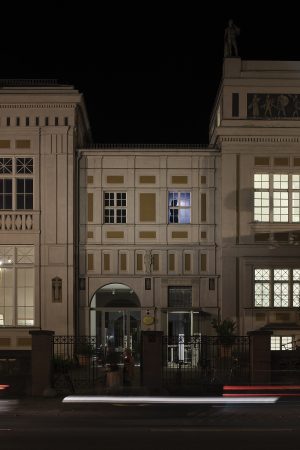
Voyeur, 2021
(photo credit: Jann Averwerser)
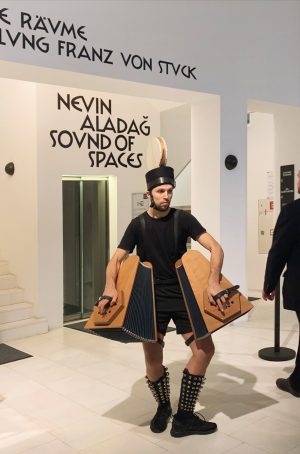
Body Instruments, 2021
performer: Darko Radosavljev
(photo credit: Nevin Aladağ)
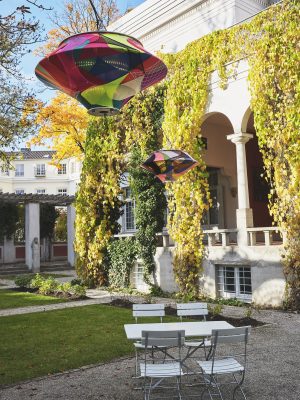
Color Floatings, blue green / Color Floating, yellow red, 2021
(photo credit: Jann Averwerser)
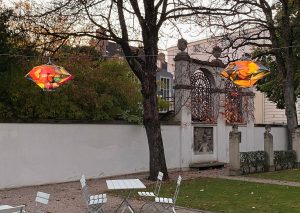
Color Floatings, blue green / Color Floating, yellow red, 2021
(photo credit: Nevin Aladağ)
Music Rooms
The exhibition inside begins in the reception rooms of Franz von Stuck. Individual pieces of furniture gently fit into the historical ambience and are only recognized at second glance as hybrids from Aladağ’s “Music Rooms” (2014–2017). The artist took pieces of furniture and everyday objects she specifically looks for at flea markets and had them converted into instruments. In selecting them, it is important to her that they are objects that could be found in any living space, though at the same time their shape and material should meet acoustic requirements. For the Museum Villa Stuck, Aladağ developed a golden “Frame Harp” that faces Stuck’s paintings of musical subjects. “Music Room Brussels,” a complete ensemble activated in monthly performances by musicians, is in the center of the sequence of galleries.
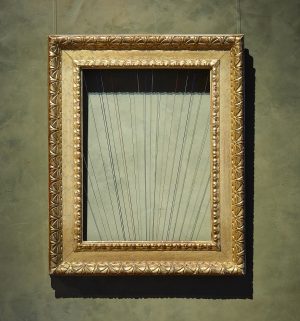
Frame Harp, Villa Stuck, 2021
(photo credit: Jann Averwerser)
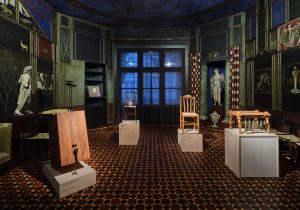
Music Room Athens, Commode Cello; Music Room Athens, Chair Lyra; Music Room Athens, Chair Kemence Adufe; Music Room Athens, Stool Pythagorean six chord, 2017
(photo credit: Jann Averwerser)
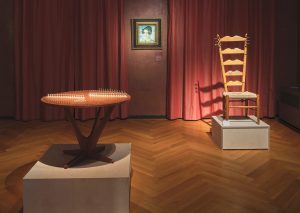
Music Room Athens, Table Santouri, Music Room Athens, Chair Saz, 2017
(photo credit: Jann Averwerser)
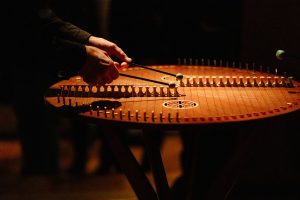
Music Room Athens, Table Santouri, 2017
(photo credit: Mirja Kofler)
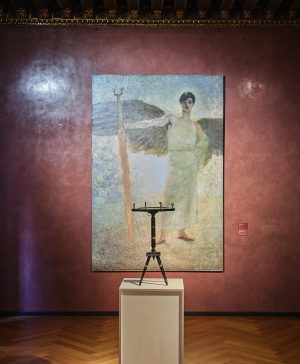
Music Room Athens, Side Table Harp, 2017
(photo credit: Jann Averwerser)
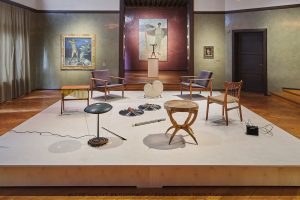
Music Room Brussels, 2015
(photo credit: Jann Averwerser)
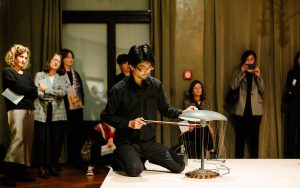
Music Room Brussels, Table Lamp Violin, 2015
(photo credit: Mirja Kofler)
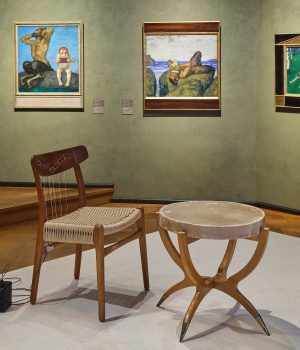
Music Room Brussels, Chair Harp; Music Room Brussels, Table Drum, 2015
(photo credit: Jann Averwerser)
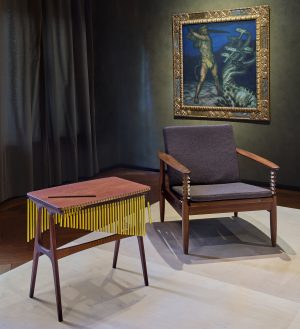
Music Room Berlin, Side Table Chimes, Music Room Berlin, Armchair Acoustic and Electric Guitar, 2015
(photo credit: Jann Averwerser)
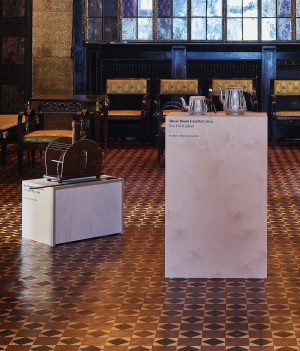
Music Room Istanbul, Newspaper Rack Violin; Music Room Istanbul, Tea Pot Kudum, 2014
(photo credit: Jann Averwerser)
Voice Over
Aladağ finds her material in everyday life, often in urban areas. In the video work “Voice Over”, which is shown in Stuck’s old studio, she combines the singing of two boys with instruments played by the wind and rain. The opening sequence featuring a harmonica that she holds in the airflow outside the car window to make it sound is a good example of the close interplay between optical and acoustic stimuli. As the instrument translates the shapes of the surrounding skyscrapers into a landscape format, the transition between the two levels becomes blurred. In this way, the artist elicits a sound both from the instrument and the image and reveals the poetry of urban space.
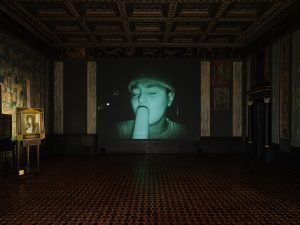
Voice Over, 2006
(photo credit: Jann Averwerser)
Patterns
On view in the first part of the upper floor are a series of works in which Aladağ experiments with patterns and ornaments of different origins that in turn create a dialogue with the decoration of Stuck’s residence. These non-acoustic works are characterized by an open structure that, analogous to the artist’s polyphonic works, allows the individual fragments to remain independent. As Aladağ describes it, she brings things together “that supposedly do not go together, because they come from different historical, religious or political contexts”. Made of synthetic hair, the curtains in the 2012 “Rehearsals” series at first glance elude classification, as the artist opens up one of her typical chains of associations: hair, hairstyle, curtains, stage .... The weightiness of the curtains as prestige objects is counterpointed with the lightness of the colorful hairstyles.
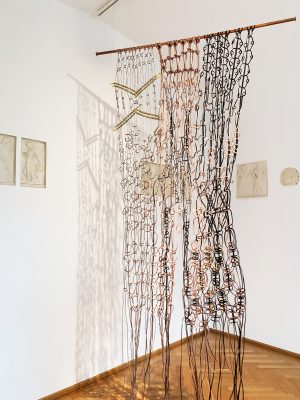
Macramé, current flow 2, 2017
(photo credit: Nevin Aladağ)
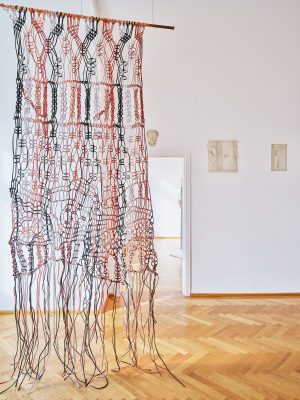
Macramé, current flow 1, 2017
(photo credit: Jann Averwerser)
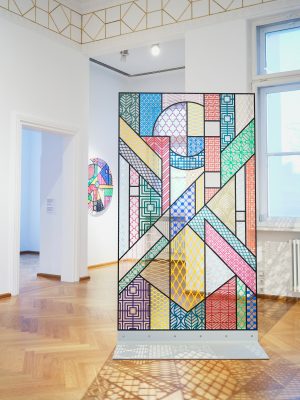
Pattern Kinship, Screen Starlight, 2021
(photo credit: Jann Averwerser)
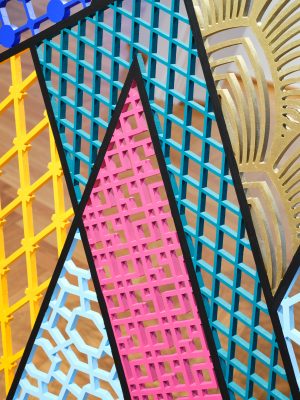
Photo detail from; Pattern Kinship, Screen Starlight, 2021
(photo credit: Jann Averwerser)
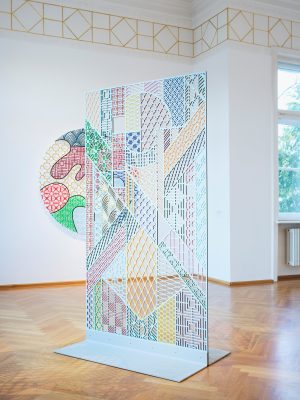
Pattern Kinship, Screen Starlight, 2021
(photo credit: Jann Averwerser)
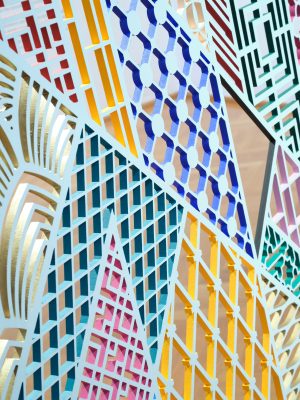
Photo detail from; Pattern Kinship, Screen Starlight, 2021
(photo credit: Jann Averwerser)
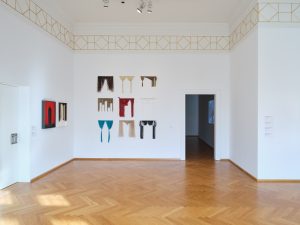
(photo credit: Jann Averwerser)
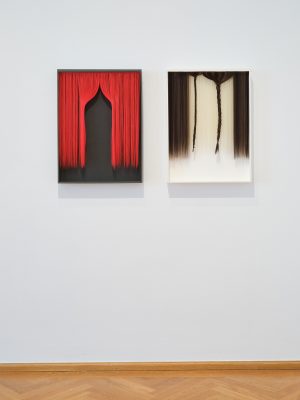
Rehearsal XII, Rehearsal IV, 2012
(photo credit: Jann Averwerser)
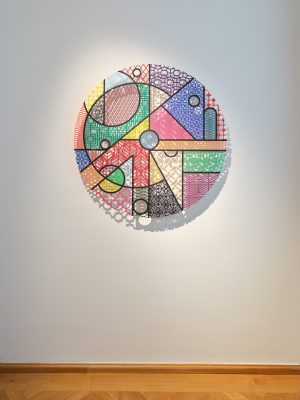
Pattern Kinship, Orbit Pop, 2020
(photo credit: Jann Averwerser)
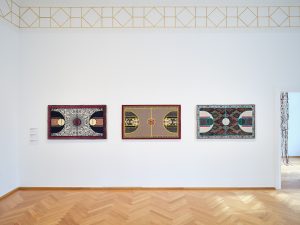
Pattern Matching, Purple-Blue, 2016; Pattern Matching, Flowers-Blue-White, 2016; Pattern Matching, Brown-Red, 2015
(photo credit: Jann Averwerser)
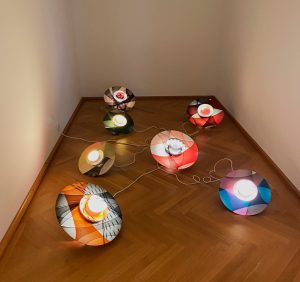
colors, 2012 / 2017
(photo credit: Jann Averwerser)
Raise the Roof; Stilettos
Raise the Roof is the title of the performance which was presented in 2017 at the Venice Biennale and served as the basis for the video work of the same title. Nevin Aladağ first conceived this invitation to dance with abandon in Berlin in 2007, where she had the dancers perform on a rooftop right by the former border between East and West Berlin. The artist contrasts the collective event with a private experience that is denied to the audience, as the songs can only be heard by the dancers. As their spontaneous dance movements reveal, each one them is alone. All that can be observed from the outside are the title and length of the various pieces that are printed on the dancers’ T-shirts. The resulting distance draws our attention to a different sound: the clatter of shoes on copper plates, which gets denser as more dancers join. The video works “City Language III” (2009) and “Top View” (2012) center on the ability of the body to produce sounds, as different people perform short pieces with their hands or feet. The artist uses the results to create unusual city portraits consisting of sound and image sequences. Such ideas also point of departure of Aladağ’s most recent work, “Body Instruments” (2021): a costume with bells, drums and accordions that is activated as part of a performance.
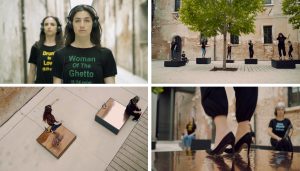
video stills: Raise The Roof, Venice, 2017
(photo credit: Nevin Aladağ)
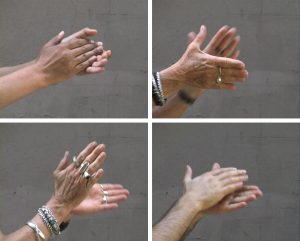
video stills: City Language III, 2009
(photo credit: Nevin Aladağ)
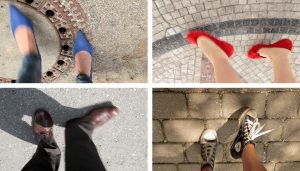
video stills: Top View, 2012
(photo credit: Nevin Aladağ)

Body Instruments, 2021
(photo credit: Jann Averwerser)
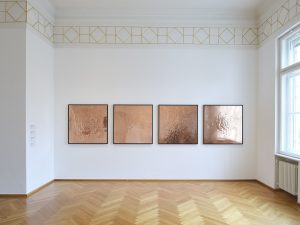
Stiletto, Woman Of The Ghetto, 8:24 min; Stiletto, Stilettos Pumps, 3:23 min; Stiletto, Wild World, 3:08 min; Stiletto, Drunk In Love, 6:21 min
(photo credit: Jann Averwerser)
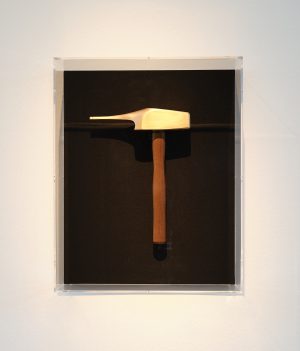
Stiletto Hammer (3.94 inch), 2013
(photo credit: Jann Averwerser)
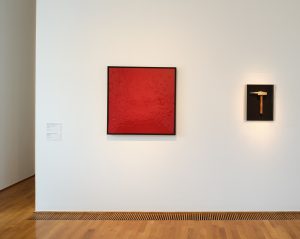
Stiletto, The Sound of Silence, 3:06 min, 2016; Stiletto Hammer (3.94 inch), 2013
(photo credit: Jann Averwerser)
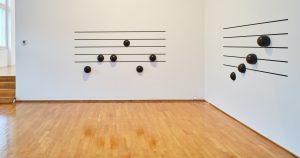
Tusch-carnival, 2015
(photo credit: Jann Averwerser)
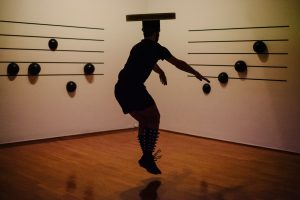
Tusch-carnival, Tusch-classic, 2015, Body Instruments, 2021
performer: Darko Radosavljev
(photo credit: Mirja Kofler)
Resonators; Social Fabric
The series “Social Fabric” (2017–2021) and “Resonators” (2018/19) are on view in the large domed room of the new studio. Aladağ creates sound sculptures that can usually be assigned to a particular family of instruments or, as in the case of the “Great Resonator,” combine multiple ones. The artist uses instruments of different origins as a starting point and combines them into geometric and imaginative shapes. She works with instrument makers to offer her technical support in her search for new sounds. The results are sometimes formally reminiscent of classical modernism and sometimes inspire conceptual associations. In “Resonator Wind,” for example, she translates the idea of an air bubble into a spherical shape to provide a common casing for the wind instruments assembled in it. Also displayed in this gallery are new, architecturally defined sound sculptures that are a further elaboration of “Resonating Space Mannheim” (2020–2021): percussive elements are displayed on the walls, while bells, a harp and a guitar are placed at the corners. The sound of spaces is the object of artistic attention; the carpet collages of “Social Fabric” draw on Aladağ’s experiments with patterns, but also affect the acoustic qualities of the space in this context. All sound sculptures are activated in regular performances.
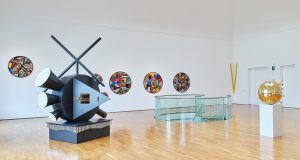
Social Fabric, South East, 2021; Resonator, 2018; Social Fabric, swinging, 2021; Social Fabric, right round, 2021; Social Fabric, bouncing, 2021; Resonating Space (Corner Guitar), 2021; Resonator Wind, 2019
(photo credit: Jann Averwerser)
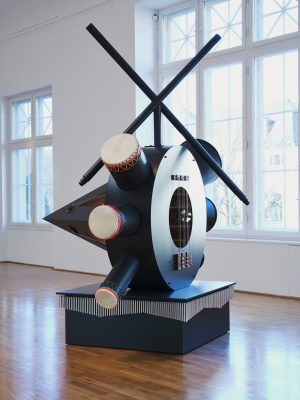
Resonator, 2018
(photo credit: Jann Averwerser)
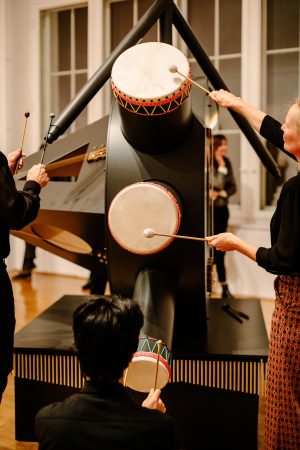
(photo credit: Mirja Kofler)
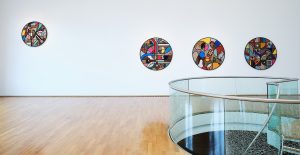
Social Fabric, South East; Social Fabric, swinging; Social Fabric, right round; Social Fabric, bouncing, 2021
(photo credit: Jann Averwerser)
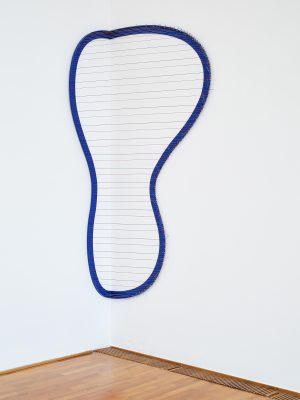
Resonating Space (Corner Harp, blue), 2021
(photo credit: Jann Averwerser)
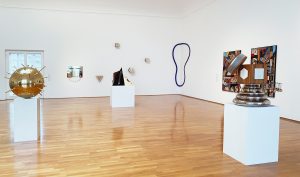
Resonator Wind, 2019; Resonating Space (Round-Bells 180°), 2021; Resonating Space Drums, 2021; Resonating Space (Corner Harp blue), 2021; Social Fabric, Social Fabric, Wind II, 2020; Percussion II, 2020; Resonator Strings, 2019; Resonator Percussion, 2019
(photo credit: Jann Averwerser)
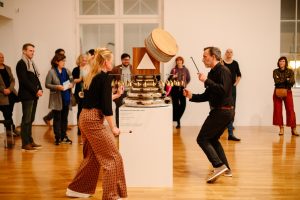
Resonator Percussion, 2019
(photo credit: Mirja Kofler)
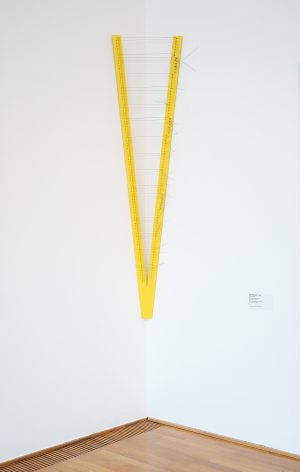
Resonating Space (Corner Guitar), 2021
(photo credit: Jann Averwerser)
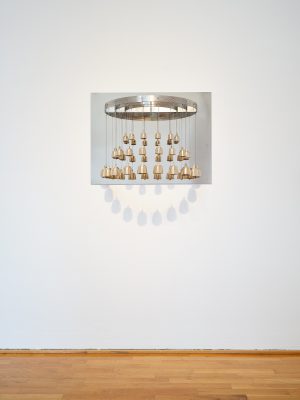
Resonating Space (Round Bells 180°), 2021
(photo credit: Jann Averwerser)
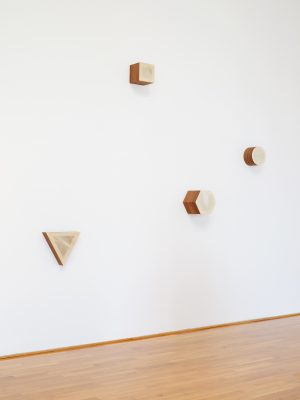
Resonating Space (Round Drum, Hexagon Drum, Triangel Drum, Square Drum), 2021
(photo credit: Jann Averwerser)
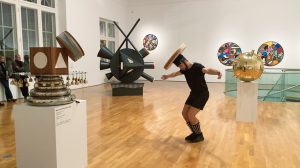
Resonating Space Villa Stuck
performer: Darko Radosavljev
(photo credit: Nevin Aladağ)
Traces; Session
The exhibition concludes with the monumental 3-channel video installations “Session” (2013) and “Traces” (2015). In carefully chosen camera shots, both works show how drums, among other objects, are played by sand and waves or even by a sprinkler system. Recurring motifs include instruments being pulled through water or held outside a car, as well as the image of rolling tambourines. While “Session” is a work commissioned by the United Arab Emirates that involves only percussive instruments, “Traces” pays tribute to Stuttgart, the artist’s childhood city. In the latter, Aladağ also employs melodic instruments, some of which are subjected to humorous transformations.
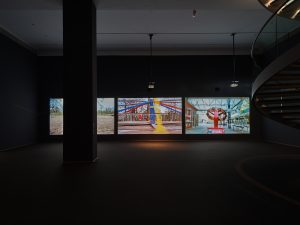
Traces, 2015
(photo credit: Jann Averwerser)
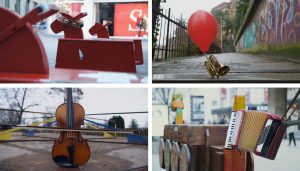
video stills: Traces, 2015
(photo credit: Nevin Aladağ)
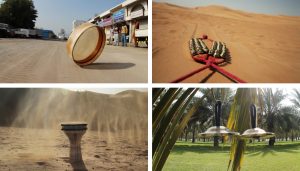
video stills: Session, 2013

















































